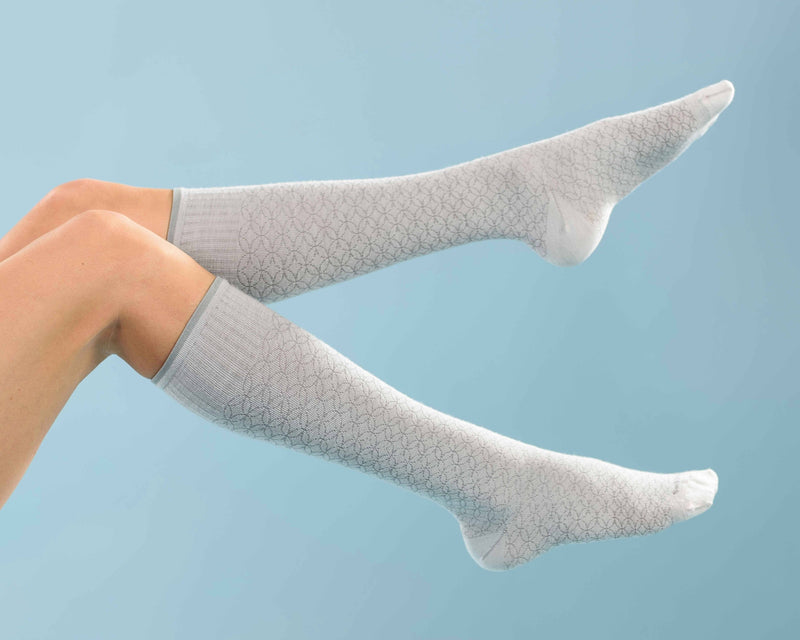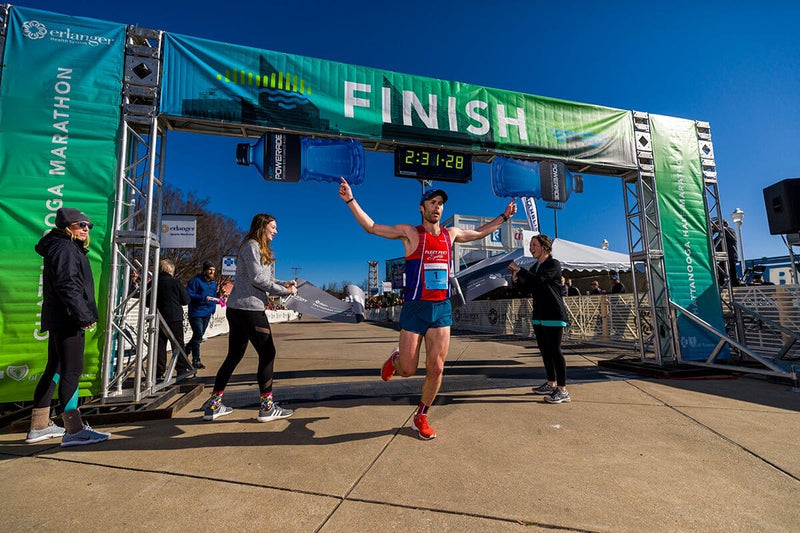
If your legs are swelling up, you're likely dealing with edema. While it can be uncomfortable, there's an easy and effective solution: compression socks. In this article, we'll break down the best options for fighting that swelling and getting you moving comfortably again.
Key Takeaways
- Edema occurs when fluid accumulates in your legs, ankles, and feet, often due to conditions like chronic venous insufficiency, deep vein thrombosis, or varicose veins, leading to swelling, discomfort, and difficulty moving.
- Compression socks are a practical solution for managing leg and foot edema by improving blood circulation, reducing swelling, and enhancing comfort.
- Different levels of compression, from moderate to extra firm, cater to varying severity of edema. Breathable materials like Merino wool, proper fit, and extra features enhance effectiveness and comfort.
- To choose the best compression socks for edema, consider the severity of your condition, select the appropriate compression level (15-40 mmHg), choose socks suited to your lifestyle and comfort needs, and consult a healthcare professional for personalized guidance.
- For easier wear, start with dry legs, roll up your compression socks to slip them on, and wash them gently with cold water, air-drying flat for longevity.
- Along with wearing compression socks, managing edema can be enhanced by staying active, propping up your legs, eating a low-sodium diet, drinking water, choosing loose clothing, and practicing gentle massage.
Edema: What It Is and Why It Happens
Ever notice your legs feel like they’re gearing up for a water performance? That’s edema—your body’s way of collecting fluid in the legs, ankles, and feet. Unfortunately, it’s less like a spa day and more like a frustrating hindrance, affecting your movement and overall comfort.
What is Edema?
Edema is that pesky swelling when fluid likes to settle in your tissues. Usually, it picks prime spots like your legs (we hear ankles are trending too). And while having attention on your legs might sound nice, this isn't quite the red-carpet moment you want. Instead, it's discomfort central—with a side of pain and challenges in moving around. It's like your body is throwing a surprise party, but without the fun.
Causes of Edema
Why is your body playing out this fluid drama? Well, meet the key culprits:
- Chronic Venous Insufficiency (CVI): You know when veins decide to go on strike? This is it. They get damaged and slack on blood circulation, causing fluid to throw a homecoming party in your legs.
- Deep Vein Thrombosis (DVT): These are serious clots that not only mess with your veins but bring on the pain. Think of them as that unexpected guest everyone talks about, and not in a good way.
- Varicose Veins: These bulging veins are like that over-inflated balloon, tired and exhausted. Apart from making you feel fatigued, they can contribute to swelling too.
While dreaming up dance routines for your leg swelling might be fun, compression socks offer a much more practical solution for managing that fluid buildup.
How Compression Socks Help With Edema
The feeling of heavy, swollen legs is never pleasant, but compression socks can offer relief. They help restore comfort and mobility, giving your legs the support they need to feel lighter and more at ease.
Improving Blood Circulation
Compression socks love to give your blood circulation a little pep talk. They apply varying levels of pressure, with a firm hug starting at your ankle that gently eases as it goes up your leg. This pressure gradient encourages blood to defy gravity and zip back up to your heart. What does this mean for you? Better oxygen delivery and waste removal, which might just make your legs feel like they're ready to dance.
Reducing Swelling and Discomfort
No more balloon-like legs. Compression socks work by encouraging excess fluid to return to the body’s core, helping to reduce swelling and ease discomfort. As the fluid drains, your legs feel lighter and life becomes more comfortable again.
Long-Term Health Benefits
The long haul is important too. While compression socks won't fix everything, they sure help promote healthier veins and reduce the risk of complications like blood clots. By keeping blood flowing, they're your new best friend in leg longevity. Who knew socks could be so charming?
What To Look For In Compression Socks For Edema
Compression socks might not get all the glory, but they’re essential for reducing swelling. Here’s what to look for when picking yours.
Level of Compression
Compression socks for edema apply varying pressure levels.
- Moderate compression, between 15 to 20 mmHg, is great if your swelling is just starting to get annoying. They promote comfort and can be worn all day without feeling like medieval torture devices.
- Firm compression, ranging from 20 to 30 mmHg, is like a supportive friend who steps in when your veins are acting up or when you're dealing with a DVT.
- Extra firm compression, at 30 to 40 mmHg, feels like a gentle but firm suggestion to that stubborn swelling if you've got more severe cases.
Material and Comfort
Let's talk fabric magic. The best compression socks use breathable materials like nylon or spandex, making them comfortable for any adventure. Pick something with moisture management properties like Merino wool to keep those little piggies dry and fresh.
Fit and Sizing
Compression socks aren't one-size-fits-all, kind of like Cinderella's slipper. Use size charts provided by manufacturers, and remember those swanky designs need to fit snugly, not loosely, to be effective. Everyone's feet are unique, and an ill-fitting sock just won't cut it.
Extra Features
Extra features? Oh, we've got those. Look for socks with seamless toes for extra comfort. Anti-odor technology is a big plus, too; no one wants socks that smell like you’ve been hiking in them for a week. Some socks even have fun colors and patterns, letting you combat edema in style.
How To Choose The Best Compression Socks For Edema
Picking the right compression socks for edema feels like choosing the perfect pair of shoes. Sure, it’s all about fit and function, but a little style doesn't hurt, either. So, let's look into some tips that’ll have your legs feeling like champs in no time.
Severity of Edema
Understanding the severity of your edema is a bit like knowing the strength of your morning coffee. It’s crucial! Compression socks come in different levels of pressure: moderate, firm, and extra firm. Moderate (15-20 mmHg) give gentle hugs, ideal for minor swelling. Need something more robust? Firm (20-30 mmHg) or extra firm (30-40 mmHg) comes to the rescue for more serious conditions like CVI or DVT. Remember, the right pressure promotes circulation, easing swelling while you strut your stuff.
- Recommended Moderate Compression Socks: Men's Snow Peak, Women's Featherweight Fancy
- Recommended Firm Compression Socks: Men's Speedway, Women's Flutter
Lifestyle and Personal Comfort
Your lifestyle is unique—like your taste in music! Whether you're a marathon runner or a “Netflix and chill” enthusiast, there's a sock for you. For active moments, go for something breathable like spandex. Spending hours on your feet? Look for socks with extra padding or seamless toes for added comfort. Stylish designs mean you won't compromise on fashion, allowing you to flaunt your wellness flair.
Consulting a Healthcare Professional
As the main character in your wellness journey, your doctor is your go-to resource for guidance. A consultation ensures you're on the right path, choosing the right compression level for your legs and boosting your confidence in sock selection.
Tips For Using Compression Socks
Congratulations on taking the step to relieve your edema woes with stylish compression socks! You're on your way to more comfortable legs, so let's check out some tips to get the most out of your fabulous new socks.
How to Put on Compression Socks
First things first: putting them on without creating a wrestling match! Bunch up the sock like it's an accordion. Slip your toes in, then work it heel-first over your foot. From there, slowly unroll the sock up your leg. And voila- you've nailed it.
Care and Maintenance
Keep your socks as fresh as the first day out of the package. Hand-wash or use a gentle cycle with cold water in the machine. Avoid washing in hot water. Air-dry them flat; let the socks enjoy a lounge day.
Best Practices For Managing Edema
Edema might seem like a stubborn guest, but you've got strategies to show it the door. Besides your trusty compression socks, let's explore a few more tactics to help manage that pesky swelling.
- Stay Active: Want a good excuse to break out those dancing shoes? Movement promotes circulation and keeps the fluid from settling in your legs. Take a brief walk, enjoy a light jog, or dance like nobody's watching. Your legs will thank you.
- Elevate Those Legs: Here’s a reason to prop up your feet! Elevate your legs above heart level when lounging. This encourages fluid flow back to the core and relieves swelling.
- Mind Your Diet: Sneaky sodium loves to hold onto water, increasing swelling. So when you're meal prepping, aim for low-sodium options. Balance it out with foods rich in potassium and magnesium like bananas and spinach.
- Hydration Alert: While it seems counterintuitive, drinking water helps flush excess fluid. So grab that chic water bottle and keep sipping throughout the day. Hydration is a key player in reducing fluid retention.
- Be Mindful of Clothing Choices: Tight, restrictive clothing can be fashion faux pas, causing fluid to pool. Opt for looser, breathable materials that allow your skin to breathe and support blood flow.
- Self-Massage for Relief: Consider a gentle massage to promote blood circulation. Use soft motions starting from the feet and moving upwards. This can help guide fluid away and provide comfort.
Adopting a holistic approach eases edema symptoms. It’s all about balance—your favorite socks plus these lifestyle tweaks. Who knew managing edema could be both effective and enjoyable?
Summing Up
Regularly using compression socks can significantly relieve the swelling and discomfort caused by edema. Opt for the correct compression level and material for better mobility and leg health. Always consult a healthcare professional for tailored advice and consider pairing your routine with lifestyle adjustments like staying active and eating well. With these changes, you can confidently manage edema and maintain both comfort and style.
Make Sockwell compression socks part of your daily defense against edema. Featuring Merino wool for maximum comfort, these socks enhance circulation, reduce swelling, and provide ongoing relief and health benefits. Show your legs some TLC—shop Sockwell socks today!


